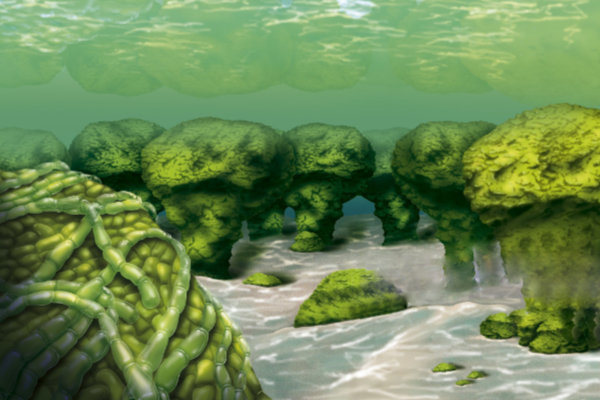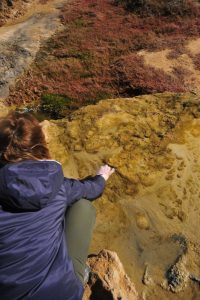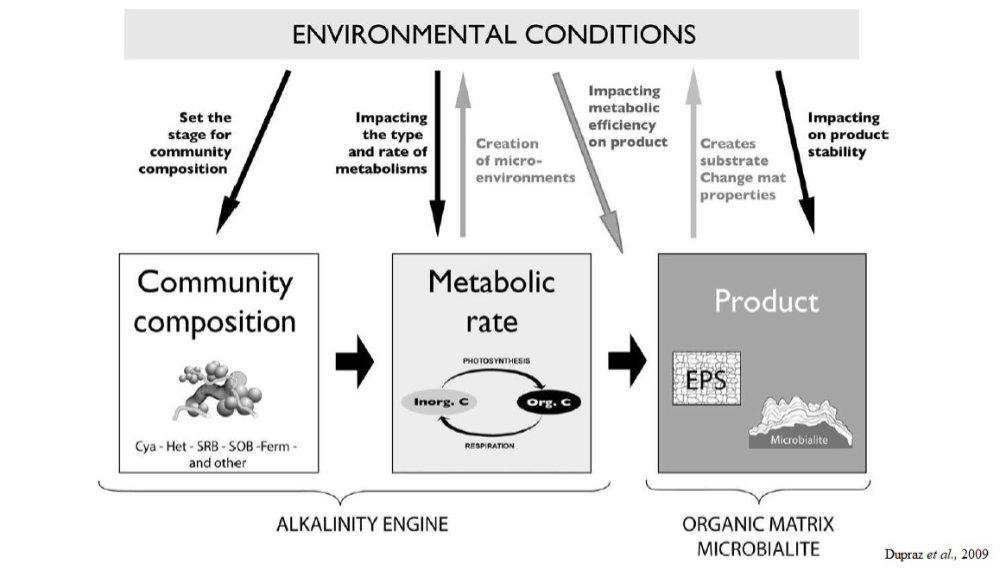thèse de Marlisa de Brito
 The role of cyanobacterial extracellular polymeric substances (EPS) in carbonate precipitation
The role of cyanobacterial extracellular polymeric substances (EPS) in carbonate precipitation
Début de thèse : septembre 2019
Financement : projet ISITE
Directeur : Pieter Visscher ; coencadrante : Irina Bundeleva
Soutenue le 29 septembre 2023
Résumé
Microbially-induced mineralization (often called ‘organomineralization’) is the process of mineral formation during metabolic activity of living microorganisms.
Organomineralization is a major structural and ecological player in the modern and in the past ecosystems and considered as one of the main natural processes controlling CO2 concentrations in the atmosphere due to carbonate (bio)precipitation, which geological record is referred as microbialites. Several processes are associated with the buildup of microbialites including sediment trapping, binding, and/or in situ minerals precipitation, which can vary in space and time with the metabolic activity of the microorganisms and the properties of their exopolymeric substances. Microbialites are found throughout the geological record and considered important biosignatures of life during the early Earth history. The oldest examples of fossil microbialites in the geological record are about 3.5 billion years old. These carbonate buildups may also proof instrumental in the search for extraterrestrial life.
Many microorganisms participate in organomineral formation: cyanobacteria, anoxygenic phototrophs, sulfate-reducing bacteria, methanogenic archaea and heterotrophic ureolitic bacteria. Among them, cyanobacteria are the dominant primary producers abundant in modern microbial mats and thus are key participants in formation of modern microbialites.
A large variety of mechanisms have been proposed to explain calcium carbonate (CaCO3) – the main mineral component of microbialites – precipitation by bacteria. Thesemechanisms have been identified and reviewed by Dupraz et al. (2009).
 The current paradigm is that in microbial mats and microbialites, microbially-induced precipitation of minerals is the most important mechanism. Two factors play a role in this: the first is a change in alkalinity that results from the metabolic reactions of the entire microbial community (as outlined above, cyanobacteria play a predominant role in this). The potential to change the local alkalinity, either favoring precipitation or dissolution, is referred to as the alkalinity engine. Metabolisms change with the time of the day, and both light and dark conditions need to be studied. The second factor is the quantity and biochemical propriety of the exopolymeric substance (EPS) produced by microorganisms. Microbial cell surface and EPS, which carry a net negative electric charge and have the capacity to bind metal ions including Ca2+, initially inhibiting precipitation. Upon alteration (including degradation) of EPS, Ca2+ is released and can precipitate as carbonate. Alternatively, the EPS-bound calcium can precipitate on the organic matrix. EPS properties are the result of its production and consumption and, consequently, change constantly. It should be noted that small organic acids – low molecular weight organic compounds (LMWOC; e.g. lactate, acetate) – play a similar role as what is outlined above for EPS. As an example of this process, Dupraz et al. (2004) observed calcium carbonate precipitation on EPS by cyanobacteria.
The current paradigm is that in microbial mats and microbialites, microbially-induced precipitation of minerals is the most important mechanism. Two factors play a role in this: the first is a change in alkalinity that results from the metabolic reactions of the entire microbial community (as outlined above, cyanobacteria play a predominant role in this). The potential to change the local alkalinity, either favoring precipitation or dissolution, is referred to as the alkalinity engine. Metabolisms change with the time of the day, and both light and dark conditions need to be studied. The second factor is the quantity and biochemical propriety of the exopolymeric substance (EPS) produced by microorganisms. Microbial cell surface and EPS, which carry a net negative electric charge and have the capacity to bind metal ions including Ca2+, initially inhibiting precipitation. Upon alteration (including degradation) of EPS, Ca2+ is released and can precipitate as carbonate. Alternatively, the EPS-bound calcium can precipitate on the organic matrix. EPS properties are the result of its production and consumption and, consequently, change constantly. It should be noted that small organic acids – low molecular weight organic compounds (LMWOC; e.g. lactate, acetate) – play a similar role as what is outlined above for EPS. As an example of this process, Dupraz et al. (2004) observed calcium carbonate precipitation on EPS by cyanobacteria.
 In sum, the precipitation and growth of organominerals is a complex process that is controlled by three main factors: (1) environmental physicochemical conditions; (2) metabolic activity of microorganisms inducing local geochemical changes; (3) production and consumption of extracellular organic matter (including LMWOC and EPS) by bacteria. The interaction of these three factors is critical for organomineralization processes.
In sum, the precipitation and growth of organominerals is a complex process that is controlled by three main factors: (1) environmental physicochemical conditions; (2) metabolic activity of microorganisms inducing local geochemical changes; (3) production and consumption of extracellular organic matter (including LMWOC and EPS) by bacteria. The interaction of these three factors is critical for organomineralization processes.
The objective of this thesis is characterizing and understanding the role of cyanobacteria and organic matter (EPS and LMWOC) produced during carbonate precipitation. For that, cyanobacterial strains with different morphology, growth rate and quantity and quality of EPS production will be investigated.
The results will be used to relate the specific cyanobacterial morphology and the properties of cyanobacterial EPS to calcium carbonate precipitation and to create conceptual models describing mechanisms of organomineralization in modern and ancient microbialites systems. The identification the cyanobacterial metabolism, which conditions may promote carbonate precipitation and allow conservation of microbial carbonate deposits, can help us to explain why some mats can lithify and others not and provide clues to access the biogenicity in the fossil record. We attempt to link the experimental results to observations in relict and fossil microbialite samples.
Mots-clés
Geomicrobiology, Organomineralization, cyanobacteria, carbonate precipitation, organic matter, microbial mats, Microscopy and Spectroscopy
Comité de suivi de thèse
Annick Wilmotte
Frédéric Marin
Composition du jury
Emmanuel Fara, université de Bourgogne – président
Maria Dittrich, université de Toronto – rapporteuse
Olivier Braissant, université de Bâle – rapporteur
Bénédict Menez, université Paris 6, IPGP – examinatrice
RaphaëBourillot l, INP Bordeaux – examinateur
Frédéric Marin, laboratoire Biogéosciences, UBFC – invité
Emmanuelle Vennin, université de Bourgogne – invitée
Pieter T.Visscher, University of Connecticut, USA; UBFC – directeur de thèse
Irina Bundeleva, université de Bourgogne – co-directrice de thèse
- extrait:
- lien_externe:
- kc_data:
- a:8:{i:0;s:0:"";s:4:"mode";s:0:"";s:3:"css";s:0:"";s:9:"max_width";s:0:"";s:7:"classes";s:0:"";s:9:"thumbnail";s:0:"";s:9:"collapsed";s:0:"";s:9:"optimized";s:0:"";}
- kc_raw_content:
 The role of cyanobacterial extracellular polymeric substances (EPS) in carbonate precipitation
The role of cyanobacterial extracellular polymeric substances (EPS) in carbonate precipitationDébut de thèse : septembre 2019
Financement : projet ISITE
Directeur : Pieter Visscher ; coencadrante : Irina Bundeleva
Soutenue le 29 septembre 2023
Résumé
Microbially-induced mineralization (often called ‘organomineralization’) is the process of mineral formation during metabolic activity of living microorganisms.
Organomineralization is a major structural and ecological player in the modern and in the past ecosystems and considered as one of the main natural processes controlling CO2 concentrations in the atmosphere due to carbonate (bio)precipitation, which geological record is referred as microbialites. Several processes are associated with the buildup of microbialites including sediment trapping, binding, and/or in situ minerals precipitation, which can vary in space and time with the metabolic activity of the microorganisms and the properties of their exopolymeric substances. Microbialites are found throughout the geological record and considered important biosignatures of life during the early Earth history. The oldest examples of fossil microbialites in the geological record are about 3.5 billion years old. These carbonate buildups may also proof instrumental in the search for extraterrestrial life.Many microorganisms participate in organomineral formation: cyanobacteria, anoxygenic phototrophs, sulfate-reducing bacteria, methanogenic archaea and heterotrophic ureolitic bacteria. Among them, cyanobacteria are the dominant primary producers abundant in modern microbial mats and thus are key participants in formation of modern microbialites.
A large variety of mechanisms have been proposed to explain calcium carbonate (CaCO3) – the main mineral component of microbialites – precipitation by bacteria. Thesemechanisms have been identified and reviewed by Dupraz et al. (2009). The current paradigm is that in microbial mats and microbialites, microbially-induced precipitation of minerals is the most important mechanism. Two factors play a role in this: the first is a change in alkalinity that results from the metabolic reactions of the entire microbial community (as outlined above, cyanobacteria play a predominant role in this). The potential to change the local alkalinity, either favoring precipitation or dissolution, is referred to as the alkalinity engine. Metabolisms change with the time of the day, and both light and dark conditions need to be studied. The second factor is the quantity and biochemical propriety of the exopolymeric substance (EPS) produced by microorganisms. Microbial cell surface and EPS, which carry a net negative electric charge and have the capacity to bind metal ions including Ca2+, initially inhibiting precipitation. Upon alteration (including degradation) of EPS, Ca2+ is released and can precipitate as carbonate. Alternatively, the EPS-bound calcium can precipitate on the organic matrix. EPS properties are the result of its production and consumption and, consequently, change constantly. It should be noted that small organic acids – low molecular weight organic compounds (LMWOC; e.g. lactate, acetate) – play a similar role as what is outlined above for EPS. As an example of this process, Dupraz et al. (2004) observed calcium carbonate precipitation on EPS by cyanobacteria.
The current paradigm is that in microbial mats and microbialites, microbially-induced precipitation of minerals is the most important mechanism. Two factors play a role in this: the first is a change in alkalinity that results from the metabolic reactions of the entire microbial community (as outlined above, cyanobacteria play a predominant role in this). The potential to change the local alkalinity, either favoring precipitation or dissolution, is referred to as the alkalinity engine. Metabolisms change with the time of the day, and both light and dark conditions need to be studied. The second factor is the quantity and biochemical propriety of the exopolymeric substance (EPS) produced by microorganisms. Microbial cell surface and EPS, which carry a net negative electric charge and have the capacity to bind metal ions including Ca2+, initially inhibiting precipitation. Upon alteration (including degradation) of EPS, Ca2+ is released and can precipitate as carbonate. Alternatively, the EPS-bound calcium can precipitate on the organic matrix. EPS properties are the result of its production and consumption and, consequently, change constantly. It should be noted that small organic acids – low molecular weight organic compounds (LMWOC; e.g. lactate, acetate) – play a similar role as what is outlined above for EPS. As an example of this process, Dupraz et al. (2004) observed calcium carbonate precipitation on EPS by cyanobacteria.
 In sum, the precipitation and growth of organominerals is a complex process that is controlled by three main factors: (1) environmental physicochemical conditions; (2) metabolic activity of microorganisms inducing local geochemical changes; (3) production and consumption of extracellular organic matter (including LMWOC and EPS) by bacteria. The interaction of these three factors is critical for organomineralization processes.
In sum, the precipitation and growth of organominerals is a complex process that is controlled by three main factors: (1) environmental physicochemical conditions; (2) metabolic activity of microorganisms inducing local geochemical changes; (3) production and consumption of extracellular organic matter (including LMWOC and EPS) by bacteria. The interaction of these three factors is critical for organomineralization processes.The objective of this thesis is characterizing and understanding the role of cyanobacteria and organic matter (EPS and LMWOC) produced during carbonate precipitation. For that, cyanobacterial strains with different morphology, growth rate and quantity and quality of EPS production will be investigated.
The results will be used to relate the specific cyanobacterial morphology and the properties of cyanobacterial EPS to calcium carbonate precipitation and to create conceptual models describing mechanisms of organomineralization in modern and ancient microbialites systems. The identification the cyanobacterial metabolism, which conditions may promote carbonate precipitation and allow conservation of microbial carbonate deposits, can help us to explain why some mats can lithify and others not and provide clues to access the biogenicity in the fossil record. We attempt to link the experimental results to observations in relict and fossil microbialite samples.
Mots-clés
Geomicrobiology, Organomineralization, cyanobacteria, carbonate precipitation, organic matter, microbial mats, Microscopy and Spectroscopy
Comité de suivi de thèse
Annick Wilmotte
Frédéric MarinComposition du jury
Emmanuel Fara, université de Bourgogne - président
Maria Dittrich, université de Toronto - rapporteuse
Olivier Braissant, université de Bâle - rapporteur
Bénédict Menez, université Paris 6, IPGP - examinatrice
RaphaëBourillot l, INP Bordeaux - examinateur
Frédéric Marin, laboratoire Biogéosciences, UBFC - invité
Emmanuelle Vennin, université de Bourgogne - invitée
Pieter T.Visscher, University of Connecticut, USA; UBFC - directeur de thèse
Irina Bundeleva, université de Bourgogne - co-directrice de thèse- titre:
- The role of cyanobacterial extracellular polymeric substances (EPS) in carbonate precipitation
- date_de_debut_these:
- septembre 2019
- nom:
- de Brito
- date_de_debut_these_numerique:
- 201909
- date_de_soutenance_these:
- 29 septembre 2023
- date_de_fin_these_numerique:
- 20230929


